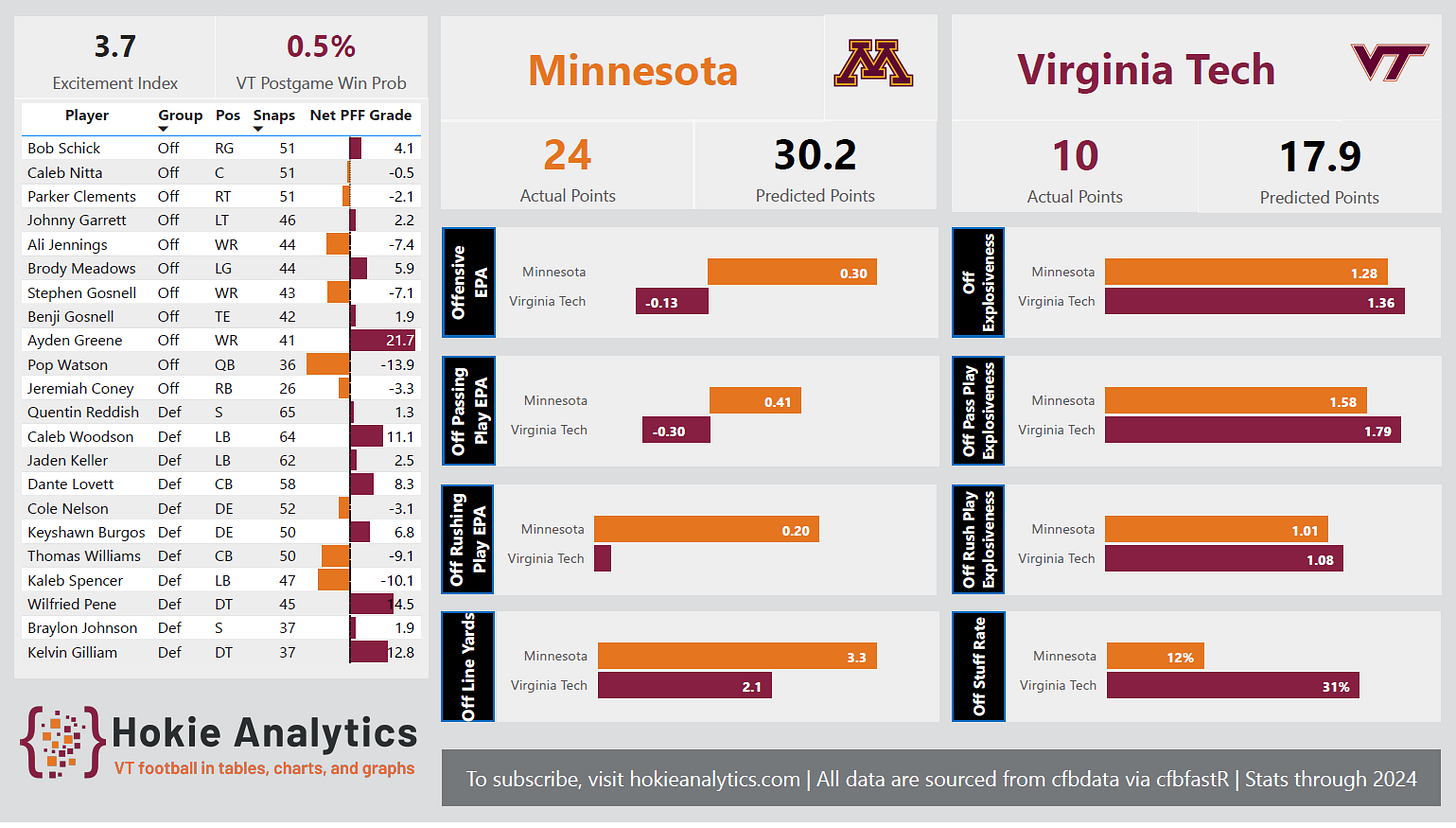What Happened at the Duke's Mayo Bowl
Despite a few inspired efforts, Hokie lose what felt like a Spring Game
There are two ways of looking at Virginia Tech’s strategic options leading up to the Duke’s Mayo Bowl:
With so many opt-outs and transfers, there is almost no chance of winning, so treat the entire experience as an opportunity to further develop the players who remain with the program.
Because of the talent and depth disparity, the only chance for victory is to call an extremely aggressive game, e.g., trick plays, exotic blitzes, and new or unused plays that have not been shown on film.
Obviously, Brent Pry & Co. went with option #1, which was in some ways disappointing. As I wrote on Friday, I was excited to see if Tyler Bowen could cook up a scheme that would give the offense a chance to put up some points.
I went to bed Friday night thinking he tossed in the towel weeks before the game even kicked off.
But I chewed on that notion for the rest of weekend and hit on a possible alternative scenario.
Perhaps, knowing his players’ limitations - experience for almost all, and talent for some (namely the walk-ons) - Bowen, as well as the defensive coaches, elected to keep things as simple as possible in the hope that it would free the players’ minds, allowing them to play fast.
Evidence in support of this theory includes:
Dearth of penalties (especially of the pre-snap variety) - just 3 total for 33 yards
No awful blown coverages or missed gap assignments - Minnesota’s longest play from scrimmage was 35 yards; in contrast, the Hokies had two plays over 40 yards
Overall, there was a lot of good, and some bad, in this game. Let’s tackle the good first.
Reasons for optimism
Prior to this game, walk-on linebacker Josh Hand had played only three defensive snaps in his career. Hand is a R-So, so he just completed his third year in the program.
On Friday, he played 14 snaps as the second-team will linebacker and acquitted himself well. According to PFF, he graded out at 60.5.
Another walk-on who really stepped up was center Caleb Nitta. Pry talked up Tommy Ricard prior to the game, so maybe there was an injury or illness that pressed Nitta into action, but he played all 51 snaps on offense and earned a 59.5 grade, which is just below the baseline of 60.
That is a really solid showing for a guy who entered the game having played only 11 snaps in his career, and those came in mop-up duty.
There were no snap or quarterback exchange issues, and he didn’t resort to holding when he got beat. And keep in mind, he is just a R-Fr.
There were other bright spots too:
Ayden Greene, who had 6 catches for 115 yards, looks like he is primed to break out in 2025. Before the game I had predicted that Ali Jennings would have a big game. Right position, wrong player.
Tyler Mason showed off his speed and graded out 30 points higher than Jeremiah Coney in pass blocking.
Bob Schick earned an 86.5 grade on his pass blocking. The Hokies are fortunate that he will return in 2025.
On defense, Caleb Woodson (71.0) and Dante Lovett (68.3) look like stars in the making. They were not perfect, but both played well in this, their sophomore seasons. They are a good off-season away from earning honorable mention All-ACC in 2025.
The defensive linemen slated to return in 2025 - listed in descending order according to the number of snaps played: Keyshawn Burgos (66.8), Kelvin Gilliam (72.8), Aycen Stevens (69.4), Jason Abbey (62.8), Emmett Laws (76.1), Jorden McDonald (70.7) and Gerard Johnson (61.2) - also turned in solid to good performances.
When Pry spoke after the game about the strong position the Hokies are in, he was no doubt alluding to the depth in the program. Most of the players listed above are a year or two away from being expected to compete for starting roles.
That these third and fourth string players held up so well against a solid Big Ten team that speaks to the level of competition within the Virginia Tech program.
The Hokies never looked like they were going to win the game, but they also did not look overwhelmed. And they competed very hard for 60 minutes. The players, and coaches, will learn a lot when they break down the game film.
Reasons for concern
The score was not indicative of how soundly the Hokies were beaten. Their post-game win expectancy was just 0.5%.
Tech’s EPA per play (-0.13) was atrocious and Minnesota’s (0.30) was comfortably above its season average of 0.20 (and the average allowed by the Hokies, which was 0.08 entering the game).
Virginia Tech’s offensive line allowed a 31% stuff rate, which resulted in the Hokies playing behind the chains all night.
And despite the individual efforts highlighted above, the Hokies’ defense allowed 3.3 offensive line yards on average per play, and achieved a stuff rate (13%) well below their season average (19%).
Really, this game reiterated a theme for the whole season. Pry & Co. have rebuilt the depth within the program, so the Hokies can absorb injuries to star players and remain competitive. This was no 2021 Pinstripe Bowl redux.
At the same time, the depth, like the starters this past season, is good, but not elite.
The 2025 team’s fate will depend on the guys the team is able to pull out of the transfer portal.



